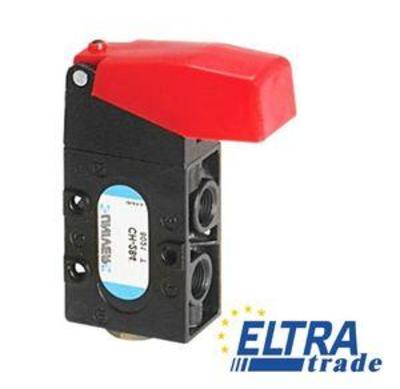Univer Pneumatic CH Heavy Duty Poppet Valve
The poppet valve is part of most reciprocating internal combustion engines, it is part of the gas distribution mechanism, which directly regulates the flow of working fluid entering and leaving the cylinder. They are also used in large compressors, steam engines.
A quality poppet valve is critical to heavy duty vehicle steering. The function of the valve is to relieve pressure on the steering, especially when the road wheels are at the limit of their turn.
How does a poppet valve work?
The valve moves along the axis of the rod, while the plate opens the way for gases, and when landing on the saddle, it tightly locks it. Some clearance between the valve stem and sleeve is necessary to avoid binding when the valve heats up and to allow the poppet to self-adjust to the seat.
The poppet valve port is opened and closed by raising and lowering the sealing surface on the port. The valve is usually held in the closed position by an internal spring. The sealing surface rises above the bore when the spring force is overcome and the valve opens.
It consists of a locking plate that covers the gate, a pair of washers, a spring and sealing rings. This is a fairly simple and very effective design, the main advantage of which is the minimum number of moving components. This means that the minimum number of potential places for future breakdowns.
Depending on the installation location, the valve opens in one phase and closes in another. Thanks to precise manufacturing and quality sealing, the closed valve seals the cylinder, protecting it from unplanned supply of the working medium, and allowing you to create the necessary working pressure.
What does a poppet valve do?
Univer poppet valves are used in most piston engines to control the flow of intake and exhaust gases through the cylinder head into the combustion chamber.
Poppet valves, a type of relief valve also known as plunger valves and restrictor valves, consist of a movable poppet shaft that covers the valve seat, led by a valve guide. The valve is held closed by inlet pressure and opens when mechanical or electrical force is applied to the shaft.
Poppet valve design
The poppet valve is fundamentally different from spool and rocker valves in that it rises off the seat in a movement perpendicular to the plane of the port, rather than sliding or rocking over it to open the port. The main advantage of a poppet valve is that it does not require lubrication since the seat does not move.
In most cases, a "balanced poppet valve" in a direct acting valve is preferred. Since all forces acting on the plate are canceled out by equal and opposing forces, less effort is required to move it. The solenoid coil only needs to counteract the force of the spring.
Poppet valve applications
In single-acting cylinders, poppet valves are widely used to hold and reduce load. They are used in piston pumps as unloading valves. In air tanks, they act as safety valves. The poppet valve is a simple solution to prevent flow reversal in a liquid circuit or to prevent contamination of individual media in mixing systems.
